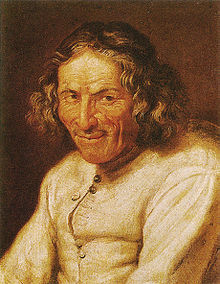Paul Scarron
Paul Scarron (born July 4 or 14, 1610 in Paris , † October 7, 1660 in Paris) was a French writer. Literary historians like to see him as a realist “avant la lettre”.
Life and work
Scarron came from a family of lawyers in Paris, received a good education and was given the minor orders in 1634, which enabled him to fill a lucrative canon fund in Le Mans in 1636 after a trip to Rome in 1635 had completed his education.
When a progressive muscle paralysis began to complicate his life in 1638, Scarron sold his benefice in 1640 and returned to Paris, where he made contact with the literary circles.
He made his debut with humorous texts: in 1643 he published the volume of poems Recueil de quelques vers burlesques (= collection of several burlesque verses), which was widely imitated. From 1648 to 1652 he worked on Le Virgile travesti [= Virgil in disguise], a parody of Virgil's epic Aeneid , which was compulsory in Latin lessons at the time and therefore well known.
Almost from the beginning he was also active as a comedy writer and remained so. a. with Jodelet ou le Maître valet [= J. or the master as a servant] (1645), Don Japhet d'Arménie (1653), L'Écolier de Salamanque [= the student from Salamanca] (1654), Le Marquis ridicule ou la comtesse faite à la hâte [= the ridiculous Marquis or the hastily created Comtesse] (1655), La fausse apparence [= the deceptive appearance] (1657), Le Prince corsaire [= the pirate prince ] (1658). With his comedies, Scarron swam on the wave of contemporary "cloak and sword pieces" ( picaresque novels ) in the Spanish style.
His greatest and most lasting success was Le Roman comique (2 vols., 1651 and 1657, unfinished), a burlesque novel that is still easy to read today, the framework and main story of which parodies the heroic-gallant novel à la Scudéry and La Calprenède with crude comedy and satirized and whose inserted novels and internal narratives are kept in the gallant-sentimental tone of Spanish models.
In 1652, a completely different campaign increased Scarron's popularity: although he was now largely paralyzed and not exactly rich, he married a 16-year-old penniless petty aristocratic orphan whom he had noticed through clever and well-composed letters: Françoise d'Aubigné, a granddaughter of Agrippa the Elder 'Aubigné , who later became the wife of Louis XIV on the left as Madame de Maintenon . Thanks to Scarron's wit and gallows humor, but also thanks to the charm and esprit of his young wife, their house became a meeting place for writers and intellectual aristocrats, which in turn helped them to receive donations from various patrons, in particular from Cardinal de Retz in the 1640s and in the 1650s, Nicolas Fouquet, Minister of Finance .
Perhaps wrongly, in 1651, during the “ Fronde ”, a political satire directed against the minister Cardinal Mazarin was attributed to Scarron , La Mazarinade . This brought him briefly into trouble in 1653, after Mazarin's victory, and caused him to be away from Paris for several months.
Scarron's work coincides with the climax of the influence of Spanish literature of the “golden age” around 1600, the “ Siglo de Oro ”, on French authors. This influence was undoubtedly partly due to the interest that Spain enjoyed as an opponent of France during the Thirty Years War and afterwards until the Peace of the Pyrenees of 1659.
Le Roman comique in German translation
- Comic novel (translator: B. in Hamburg on March 26, 1752) online - Internet Archive . Johann Carl Bohn , Hamburg 1764 (3rd edition)
- Comic novel 3rd part (Translator: B. from W. on August 30, 1753) online - Internet Archive . Johann Samuel Heinsius the Younger , Hamburg 1753
- The comedian novel online - Internet Archive . Translator: Franz Blei . Georg Müller , Munich 1908
Web links
- Current directory of Scarron's works in VD 17
- Literature by and about Paul Scarron in the catalog of the German National Library
- Works by and about Paul Scarron in the German Digital Library
- Works by Paul Scarron in the Gutenberg-DE project
- Paul Scarron on the Internet Archive
- Gert Pinkernell: Article in “Names, titles and dates of the French. Literature " (main source)
- Biography (french)
| personal data | |
|---|---|
| SURNAME | Scarron, Paul |
| BRIEF DESCRIPTION | French author |
| DATE OF BIRTH | July 4, 1610 or July 14, 1610 |
| PLACE OF BIRTH | Paris |
| DATE OF DEATH | October 7, 1660 |
| Place of death | Paris |

